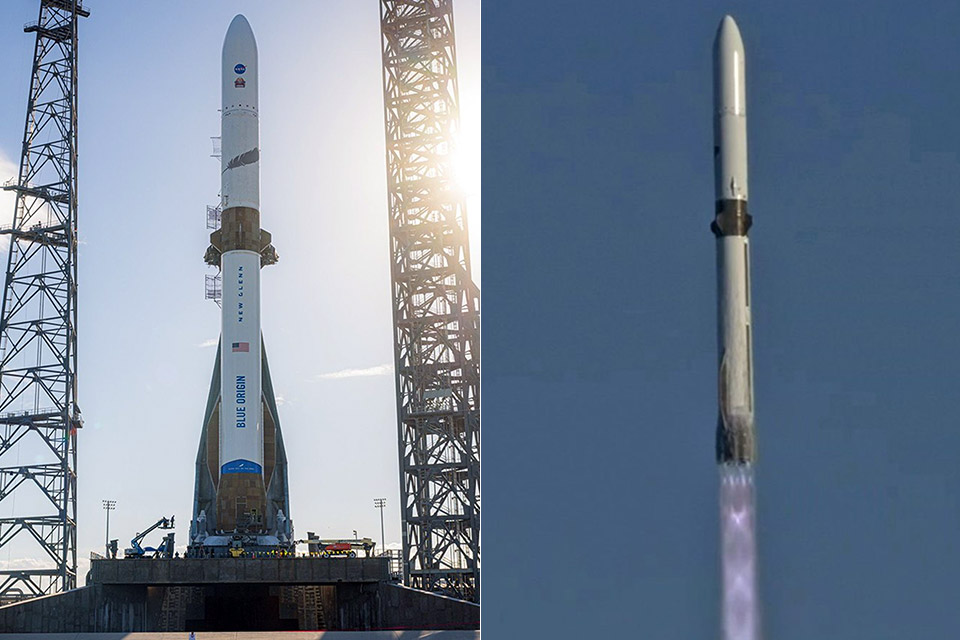Blue Origin’s New Glenn Clears the Pad, Delivers NASA’s Twins to Mars’ Doorstep


On Thursday afternoon in Florida, a roar echoed over the Atlantic as Blue Origin’s New Glenn rocket lifted off from Launch Complex 36. Liftoff was at 3:55 p.m. Eastern, right in the middle of an 88-minute window that had been clear of previous issues. The vehicle, painted white and blue, rose steadily on clouds of fire from its seven BE-4 engines, carrying two small, but mighty, spacecraft from NASA.
Delays had been stacking up like storm clouds over Cape Canaveral, with the initial intention for a Sunday launch, but weather fronts and a cruise ship in restricted seas forced a cancellation. Ground equipment concerns exacerbated the frustration that day. By Wednesday, the sun had decided to get involved, unleashing coronal mass ejections—giant blasts of solar plasma—that caused a geomagnetic storm severe enough to shut down operations. Teams were monitoring the chaos based on NOAA projections of communication and navigation problems. Proton fluxes were surging, threatening electronics in orbit. But by Thursday, things had improved enough. A technical issue caused a last second hold 20 seconds before liftoff, but determination won out. Forecasters from the 45th Weather Squadron said the chances of success were above 95% with solar activity reduced to moderate.

LEGO Icons NASA Artemis Space Launch System – DIY Rocket Model Building Set for Adults, Ages 18+ – Gifts…
- NASA rocket model kit – Launch into a creative project with the LEGO Icons NASA Artemis Space Launch System model building project for adult space…
- What’s in the box? – This creative building set includes everything you need to craft a multistage rocket with 2 solid-fuel boosters, an Orion…
- Features and Functions – This NASA-themed rocket model features retractable launch tower umbilicals, rocket support and crew bridge, detachable…
The engines roared for just over three minutes until the first stage shut down and separated. That booster, nicknamed “Never Tell Me the Odds,” splashed down tail first into the ocean, its three gimbaling engines doing a reentry burn to slow its descent. Nine minutes and 15 seconds after liftoff, it landed on the deck of Jacklyn, Blue Origin’s recovery barge 620 miles downrange. As the legs deployed, salt spray erupted, and New Glenn had its first clean catch. During the first flight earlier this year, those same engines failed to relight and the previous booster dropped into the sea. This time, precision was key. The engineers on the livestream let out controlled cheers, a testament to the hard work of turning a 98-meter monster into something that could fly again—up to 25 times if all goes according to plan.
The second stage took over, powered by a pair of BE-3U engines that burned liquid oxygen and hydrogen to drive it higher. As the fairings were expelled like a couple of discarded shells – away with the covering – and vedda pen, we might as well take a good look inside at the cargo: NASA’s ESCAPADE duet, also known as Blue & Gold. Rocket Lab in Long Beach manufactured each of those cube-shaped probes for NASA; they’re a meter across and weigh 535 kilograms when fully fueled. Then, after a second burn of the upper stage, Blue broke free from its ESPA ring adapter at 33 minutes, followed by Gold 30 seconds later, and before you knew it, they were in a medium Earth orbit, rushing toward escape velocity. Meanwhile, the first stage is taking a slight detour to Mars. A Viasat demo payload remained trapped on the upper stage, but fired up shortly after to test real-time data relay systems across L-band networks, as part of NASA’s push to use commercial communications rather than internal systems.
Those probes are now off on an exceedingly long slow dance across space, with Rocket Lab’s team in California giving them a thorough inspection right away. 14 days in, a little burn sends them on a path to the Earth-sun L2 point, a million and a half kilometers away. They’ll spend a year floating in space, sketching some strange kidney bean shape while suffering the cold and radiation. It’ll be late 2026 before they get a tug back towards home, launching them off on an 11 month journey to the Red Planet – they’ll be arriving a couple of days apart in September 2027, taking what we guess would be some pretty intense insertion burns to get them into there elliptical orbits that get tighter in time. Berkeley’s space scientists then take over, keeping a close eye on devices monitoring the force of the solar wind on Mars’ tiny magnetic shield.
Blue Origin’s New Glenn Clears the Pad, Delivers NASA’s Twins to Mars’ Doorstep
#Blue #Origins #Glenn #Clears #Pad #Delivers #NASAs #Twins #Mars #Doorstep








